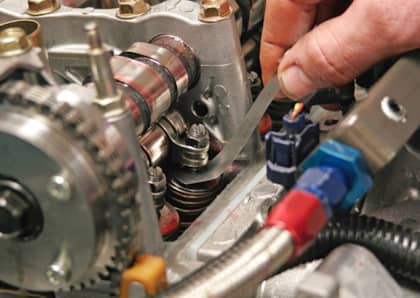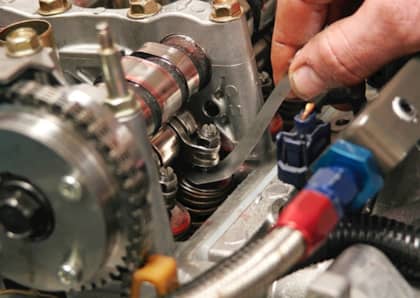If You Don't Think Air/Fuel Matters, Think Again
20 years ago, if you wanted to see how close your four-cylinder Honda engine was to blowing itself to smithereens, you’d pluck its sparkplugs and pretend like you knew what you were looking at. That brownish shade of speckled-up porcelain typically meant you needed to do something pretty important, like adjust that fuel pressure, lay off the boost or top off with something that wasn’t 87-octane.
20 years ago, you also rented tapes from Blockbuster. Like being charged for returning “Dances With Wolves” a day late, yanking those plugs to see what was happening inside of those cylinders is just as outdated and, today, every bit as unnecessary.

That’s because of how prevalent and inexpensive electronic air/fuel meters have become—those devices that, once upon a time, were cost-prohibitive, bulky and exclusive to high-dollar tuners and professional race teams.
Air/Fuel Ratios Explained
But you aren’t interested in investing in any sort of air/fuel meter until you understand exactly why all of that air and fuel inside of your engine’s got to be monitored in the first place. However, to do that, you’ve got to understand how fuel-injected internal combustion engines work.
It starts with air that passes through a filter, goes past a series of pipes or tubes, through a throttle body(s), and into an intake manifold where it’s distributed to each of the cylinder head’s intake ports. Once it passes the intake valves that airstream joins whatever fuel mixture’s been injected into the combustions chambers by way of the car’s computer-controlled fuel pump and fuel injectors.
It’s this fuel mixture that should make you care about air/fuel ratios, though. That’s because neither you nor your car’s ECU have a whole lot to say about how much air can make its way into those combustion chambers—atmospheric pressure, engine displacement and engine speed determine that on their own—but you’ve got a whole lot of control when it comes to delivering that fuel.
Air/fuel ratios determine things like whether or not you’ll melt a piston, how much power you’ll make and how much fuel it’ll take for you to get to Blockbuster and back (#throwback to '96!). Ask your engine and it’ll tell you that, most of the time, that ratio ought to be somewhere close to 14.7:1. We’re talking about stoichiometry, also known as lambda; in other words, the point in which 14.7 parts of air for every single part of fuel are lingering about those combustion chambers. Decrease that ratio any further—which’ll look something like, say, 13.8:1—and you’ve got yourself a rich condition where too much fuel’s been added. Do the opposite and, all of a sudden, the situation’s gotten lean.
But don’t think for a minute that that 14.7:1 ratio is every engine’s target—at least not all the time. Often times a marginally richer condition is justified, even required, with high-horsepower situations where more fuel creates a cooling effect (among other things), and in other cases, a ratio slightly leaner than stoichiometric is acceptable in order to achieve lower emissions, for instance. Veer too far off either way, though, and you’re asking for trouble. Excessively rich conditions can lead to a dramatic power drop and piston rings that’ll no longer seal. Go too lean for too long and the results can be catastrophic, not to mention expensive.
Enter the Air/Fuel Meter
There’s more than one kind of air/fuel meter, but all of them have the same job: to monitor how much air and fuel have been burnt within the combustion chambers, and deliver that information to whoever wants it. Every air/fuel meter is made up of some sort of digital gauge or display and an oxygen sensor positioned right in the middle of the engine’s exhaust stream that sends data to the meter’s brains, which are typically encapsulated within that gauge or display. As long as that engine of yours is running, there’s information to be had from that meter.

The Oxygen Sensor
No matter what kind of air/fuel meter you’re looking at, it relies on an oxygen sensor positioned within the engine’s exhaust stream that sends the information you need to know to whatever screen or gauge it’s paired with. You’re the kind of person who knows what he’s doing, which means you’ll take that information and make all sorts of important adjustments to your fuel system and that tunable ECU of yours that’ll let you do things like make more power, get better mileage and not blow things up.

The oxygen sensor your bone-stock Focus has already does something similar. The factory ECU figures it all out, adjusting things like fuel and ignition maps, without you ever knowing a thing or lifting a finger.

Narrowband or Wideband
However, there are two kinds of oxygen sensors you need to know about: 1) older and slower narrowband sensors that are only able to monitor a limited range of activity, and 2) newer and quicker wideband sensors that are able to retrieve a whole lot more information. Narrowband sensors are fine so long as you’re okay with only knowing what’s going on around your engine’s stoichiometric range—or lambda—which is really just a fancy way of designating the point at which enough air’s been added to burn every bit of fuel. It’s the sort of sensor your Focus has and, for the purpose of getting you to work and back, is quite capable.

The bad news for narrowband sensors is that they’re just not able to detect changes that go too far beyond stoichiometric, which, in the case of that turbocharged engine of yours that may dip into the 11.0:1 range on occasion, makes them pretty much useless.

Wideband sensors, on the other hand, can register data over a much broader spectrum, which means that 11.0:1 air/fuel ratio you wish you knew about is now displaying right on your dash. If you’re ready to step up to some sort of air/fuel meter, you’d be a loon to consider anything other than a wideband.
What the Wideband Does
Like any air/fuel meter, wideband air/fuel meters—or wideband controllers—allow you to monitor how much air and fuel has been burnt, but the wideband will deliver that information a whole lot quicker and across a wider spectrum. Almost every wideband controller you can buy uses the same Bosch LSU 4.9 Oxygen Sensor, but some are able to interpret and deliver the data that that oxygen sensor delivers a whole lot faster than the others. That’s because of the unique circuitry that makes up a given wideband controller, which affects how fast and how accurate it’ll be.
You might not think speed matters here, but you’d be wrong. A high-compression, turbocharged engine operating on the edge of failure and peak power can’t afford the extra millisecond it’ll take an inferior controller to deliver the tuner the information he needs. Get informed quickly enough and, all of a sudden, you’ve avoided blowing up several thousand dollars worth of pistons and rods and, instead, backed off the throttle right in time.
What Deadtime Means to You
No air/fuel meter is instant, though. Until physics and thermodynamics let you stick a sensor smack dab inside your combustion chambers, you’ll have to wait for that exhaust stream to reach that oxygen sensor of yours. We’re talking about deadtime, which is nothing more than the delay between air/fuel ratio changes and the meter actually being able to tell you what they are and, this side of positioning that oxygen sensor as close to the turbine or exhaust collector as possible, there isn’t a whole lot you can do about it...
...unless you’re AEM, whose X-Series Wideband UEGO Air/Fuel Sensor Controller Gauge has been proven to decrease deadtime, delivering data to whoever wants to look at it faster than any other controller out there.

Still don’t care about deadtime? Consider this: when reviewing air/fuel ratio data while tuning, longer deadtimes can skew when specific air/fuel ratios appear. In other words, you might be adding or taking away fuel at the wrong times, which means you haven’t fixed the problem and, in some cases, might even make it worse.

AEM Electronics claims to have the fastest, most accurate and detailed wideband air/fuel meter around. If you use that Google machine of yours, you’ll see that nearly 20 independent tests agree with them. According to AEM, its X-Series controller prevails in almost every throttle-sweeping situation you could test it in: at steady-state as well as while quickly stepping on and off that gas pedal—the three points in which you’re most likely to experience significant air/fuel ratio changes. In terms of speed, AEM’s X-Series controller wins; it might be the only thing between you and an engine rebuild you never planned on.
(Photos: Courtesy of AEM Electronics)











